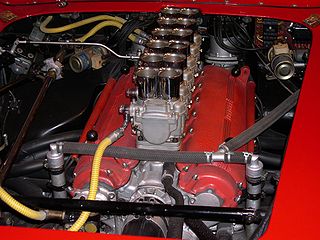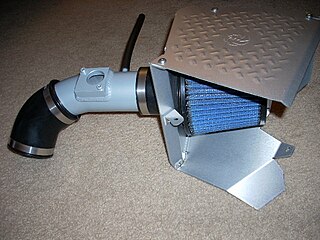
A turbocharger, colloquially known as a turbo, is a turbine-driven forced induction device that increases an internal combustion engine's efficiency and power output by forcing extra compressed air into the combustion chamber. This improvement over a naturally aspirated engine's power output is due to the fact that the compressor can force more air—and proportionately more fuel—into the combustion chamber than atmospheric pressure alone.

A carburetor or carburettor is a device that mixes air and fuel for internal combustion engines in the proper air–fuel ratio for combustion. It is sometimes colloquially shortened to carb in the UK and North America or carby in Australia. To carburate or carburet means to mix the air and fuel or to equip with a carburetor for that purpose.

An intercooler is a mechanical device used to cool a gas after compression process, Compression process increases the internal energy of the gas which in turn raises its temperature and reduces the density. In other words intercooler is a device used in compression process, typically a heat exchanger that removes waste heat in a gas compressor. They are used in many applications, including air compressors, air conditioners, refrigeration, and gas turbines, and automotive engines. Here they are widely known as an air-to-air or air-to-liquid cooler for forced induction internal combustion engines to improve their volumetric efficiency, which they do by increasing intake air density through nearly constant pressure cooling.

A cold air intake (CAI) is usually an aftermarket assembly of parts used to bring relatively cool air into a car's internal-combustion engine.
Volumetric efficiency (VE) in internal combustion engine engineering is defined as the ratio of the mass density of the air-fuel mixture drawn into the cylinder at atmospheric pressure to the mass density of the same volume of air in the intake manifold. The term is also used in other engineering contexts, such as hydraulic pumps and electronic components.

A cooling tower is a heat rejection device that rejects waste heat to the atmosphere through the cooling of a water stream to a lower temperature. Cooling towers may either use the evaporation of water to remove process heat and cool the working fluid to near the wet-bulb air temperature or, in the case of closed circuit dry cooling towers, rely solely on air to cool the working fluid to near the dry-bulb air temperature.
A solar chimney – often referred to as a thermal chimney – is a way of improving the natural ventilation of buildings by using convection of air heated by passive solar energy. A simple description of a solar chimney is that of a vertical shaft utilizing solar energy to enhance the natural stack ventilation through a building.

In automotive engineering, an inlet manifold or intake manifold is the part of an engine that supplies the fuel/air mixture to the cylinders. The word manifold comes from the Old English word manigfeald and refers to the multiplying of one (pipe) into many.

Inlet cones are a component of some supersonic aircraft and missiles. They are primarily used on ramjets, such as the D-21 Tagboard and Lockheed X-7. Some turbojet aircraft including the Su-7, MiG-21, English Electric Lightning, and SR-71 also use an inlet cone.
Manifold vacuum, or engine vacuum in an internal combustion engine is the difference in air pressure between the engine's intake manifold and Earth's atmosphere.

A ram-air intake is any intake design which uses the dynamic air pressure created by vehicle motion to increase the static air pressure inside of the intake manifold on an internal combustion engine, thus allowing a greater massflow through the engine and hence increasing engine power.

An intake or inlet is an opening on a car or aircraft body capturing air for operation of an internal combustion engine.
Carburetor, carburettor, carburator, carburettor heat is a system used in automobile and piston-powered light aircraft engines to prevent or clear carburetor icing. It consists of a moveable flap which draws hot air into the engine intake. The air is drawn from the heat stove, a metal plate around the exhaust manifold.
A ground-coupled heat exchanger is an underground heat exchanger that can capture heat from and/or dissipate heat to the ground. They use the Earth's near constant subterranean temperature to warm or cool air or other fluids for residential, agricultural or industrial uses. If building air is blown through the heat exchanger for heat recovery ventilation, they are called earth tubes (also termed earth cooling tubes, earth warming tubes, earth-air heat exchangers, air-to-soil heat exchanger, earth channels, earth canals, earth-air tunnel systems, ground tube heat exchanger, hypocausts, subsoil heat exchangers, thermal labyrinths, underground air pipes, and others.
In engine technology, a reverse-flow or non-crossflow cylinder head is one that locates the intake and exhaust ports on the same side of the engine. The gases can be thought to enter the cylinder head and then change direction in order to exit the head. This is in contrast to the crossflow cylinder head design.

In supersonic aerodynamics, unstart refers to a generally violent breakdown of the supersonic airflow. The phenomenon occurs when mass flow rate changes significantly within a duct. Avoiding unstarts is a key objective in design of the engine air intakes of supersonic aircraft which cruise at speeds of M2.2+.

This article briefly describes the components and systems found in jet engines.

A splitter plate is a component in some jet aircraft, used to control the airflow into the engine. Where the engine air intake is mounted partway back along the fuselage or under the wing, the splitter plate diverts the boundary layer away from the engine intake. It is a form of boundary layer control.












